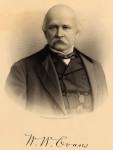The first civil engineers were travelers. Many of them went far and wide to engage in their work. This may not seem like a big deal in modern times, but when you think about the means of travel in the mid-nineteenth century; it's quite amazing. These men were creating the next best mode of transportation -- railroads. While much of this work was in progress in the United States, other countries were also investing in this transportation infrastructure. Some of the first U.S. engineers traveled to South America to build railroads. Anthony Walton White Evans (let's call him Walton) was commissioned to build the Copiapo Railraod in Chile in 1850.

Walton reached Caldera, Chile by ship on May 21, 1850. He worked on the Copiapo Railroad and other civil engineering projects in the vicinity for almost two years. His biggest challenge was the local labor force. Local men he referred to as "peons" were unreliable and caused trouble with the Americans. There were also mini-revolutions that disrupted work and required government forces to put down. In one of his diaries, he described an insurrection by "peons" who attacked his house with stones. Walton was "forced to fire upon them wounding some."
After trips to Europe and New York, Walton traveled to Peru in 1854 to build the Arica-Tacna Railroad. In addition to similar challenges of local labor and revolutions, yellow fever struck. Several men died and Walton himself was ill for several weeks. In 1856, he returned to New York to marry Anna Zimmerman. They married in June and in November they boarded a ship to Chile. Over a period of four years, he worked on the Southern Railroad and various civil engineering projects in Chile and Peru. Walton worked as a consulting engineer for the remainder of his career. He lived in New Rochelle, NY and worked mostly in New York City. He served as a delegate to the International Congress on the Canal at Paris in 1879 and wrote extensively on his opinion of the Panama canal route.
We are fortunate to have the papers of Anthony Walton White Evans in the Institute Archives and Special Collections. Here you can read diaries that detail his engineering work and his professional and family correspondence. The collection also contains some interesting artifacts, including Walton's personal hygiene kit, which he likely carried with him on his travels to South America and Europe.
